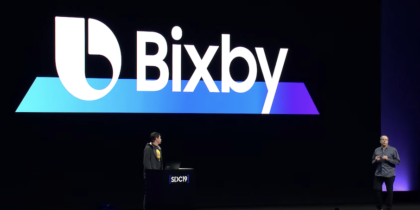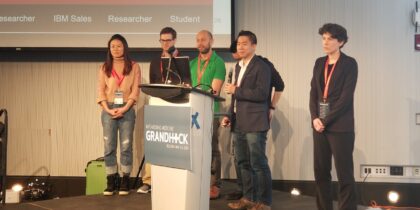In this News Insight, Fast Company discusses how work is set to change dramatically as automation pushes future workers to roles and tasks that are quintessentially human. For a nearer-term view, download our white paper on the Next Mobile Economy, outlining how business leaders should rethink their business models and get into the driver’s seat of mobile transformation. —Samsung Insights editorial team
The workplace has evolved dramatically in the past 100, 50, even 10 years; but to the futurists whose job it is to consider where all these changes are taking us, we’re only just beginning a revolution that will completely redefine why, where, when, and how we work.
London-based online office marketplace Hubble recently asked a pair of futurists to explore what the workplace of the 2030s and 2100s will look like, and the results paint a more completed picture of a world that’s already begun to emerge.
They believe that automation will push future workers to roles and tasks that are quintessentially human, abolishing leftover vestiges of the industrial revolution–such as standardized working hours and traditional hierarchies–toward something that more resembles the tribal and community-oriented work structures of pre-industrial times.
“If you look at the way we lived nomadically early on, it was very important to be with other nomads who were good for you, helping your survive,” said Liselotte Lyngsø, founding partner of Copenhagen-based consultancy Future Navigator. “I think we can use that as a metaphor for the way we’ll organize our work life in the future; you need to be in a tribe where you are better at getting things done together.”
Retiring the concept of retirement
Lyngsø explains that as technology becomes more sophisticated human labor will eventually be rendered less efficient and affordable than robotic alternatives. As a result, most humans will instead focus their energy on finding creative solutions to problems that can’t be solved by a computer.
“The machines will become very good at being machines in the years ahead, so we need to be extremely good at being humans again,” she says. “That means we really have to dig into individual abilities, allowing people to do their best and live out their potential.”
Human potential, according to Lyngsø, is not best cultivated in today’s workplace structure, and many of the changes she predicts revolve around the ongoing effort to maximize the abilities of individuals. To that end, many of today’s workplace structures, such as the 9-to-5 workday, traditional offices, rigid hierarchies, and the very concept of retirement will change dramatically.
“I don’t think we’ll have work hours like we used to. Likewise I think we’ll replace retirement with breaks where we reorient and retrain, where the borders [of work] are blurred,” she says. “It’s also about creating a sustainable lifestyle so you don’t burn out, and you can keep working for longer.”
Instead of the standard retirement age, Lyngsø believes there will be multiple breaks throughout one’s career, and a range of alternative workplace structures that individuals can pursue based on what best fits their lifestyle, including part time and contract work.
“Instead of saving the dessert for last we should have a few bites throughout our life,” she says. “We’ll see a whole patchwork of different ways of participating in the labor market.”
From head hunting to “team hunting”
In a world where machines are better at completing more mundane and physically demanding tasks, humans will have the ability to follow their passions, and pursue more meaningful work.
“A team in a physical framework shouldn’t be these big office spaces, it should be maximum eight or 10 people–enough to share two pizzas–that’s what we believe is optimal for being innovative,” says Lyngsø. “We used to hire people for specific functions because of this conveyer-belt thinking, which was a great way for controlling people, but it’s not how you get the best out of people; In the future it’s about getting the team to flourish.”
Lyngsø adds that artificial intelligence tools and algorithms will help determine the optimal size and makeup of these teams based on complimentary personality traits and skills. As these teams establish their abilities within an industry or framework Lyngsø believes recruiters and employers will try to keep them intact.
“We’ll see teams recruited together because they work well together, but also they’ll realize their collective power, and they’ll start moving around as a team, almost like a marching band,” she says, adding that teams will also negotiate collective benefits like insurance and healthcare, and could even choose to live together or close to each other for added convenience.
The future is female (kind of)
Since women today are more educated than men, Lyngsø believes their representation in the workforce will gradually increase from the current 46% to gender parity in the 2030s, and a 53% share of employment in the 22nd century.
At the current rate, however, the World Economic Forum predicts that the gender pay gap won’t close for 217 years, and will remain at 10% by the year 2100. Breaking away from that trend line, according to Lyngsø, will require a significant change in culture.
“Gender equality is not going to come about by itself,” she says. “But as a futurist I need to consider a scenario where it goes in the opposite direction as well, because that is also possible.”
Less work, more play
When work is as much about reaching your potential and pursuing your passions as it is about earning a living, measuring productivity in hours and minutes will seem arcane. In fact, futurist Yesim Kunter is convinced that technological advancement will finally enable humans to work fewer hours each week than generations past, even though similar predictions have since failed to come to fruition.
“Work/life balance is going to be more important, especially if you believe our life experiences actually help our work by inspiring us,” she says. “We need that cooling off time so we can reflect and understand what we’ve done, and clear up our minds so we can be more efficient and effective in what we’re doing.”
The London-based futurist consultant and former employee of Toys R’ Us, Hasbro, and LEGO now works closely with the toy industry to help develop tools that will prepare children for their future careers. While the Internet, mobile technology, and other recent advancements have led to an always-on working culture, she believes generations that are raised with these technologies will be keen to take a step back from them.
“Technology today is still very new for us,” says Kunter. “For kids growing up today it won’t be that interesting–it will just be a normal thing–and they won’t be as interested in checking their phone all the time. They will seek more of a balance.”
As a result, Kunter predicts that by 2030 the average workweek will drop to 36 hours from 37 and a half today, and continue down to 30 hours by the year 2100.
Redefining leadership
In a future that emphasizes getting the most out of the individual, and where the individual is driven by passion, Kunter believes the concept of leadership will be synonymous with motivation.
“Because they are working for a cause, something they believe in, if the company can create that it will become much easier for people to understand each other, appreciate each other and support each other, but it comes from the top; leadership is the most important thing,” she says.
Should Lyngsø’s vision of a workplace that focuses on small, decentralized teams over large groupings and rigid hierarchies come to fruition, she suggests the definition of leadership will similarly become more fluid. While Kunter believes many will continue to work in a more traditional company setting both suggest leaders will arise naturally from the group.
“Every company has a different motivation factor; the energy inside will create the leader and structure of the company,” says Kunter. “It’s hard to generalize, but probably the real leaders will come up based on how they work and how they bring people together, because the real leader is whoever is being followed, not the person who is given the role of manager.”
The only constant is change
While both futurists stand behind their predictions they qualify them with a healthy dose of skepticism, suggesting ways in which their vision of the future may fall flat.
Kunter, for one, says that while today’s move towards more free flowing work structures appeals to the current workforce future generations may actually choose to go in the opposite direction.
“Because of helicopter parenting and extremely scheduled timing for children these days, kids want instructions, they want direction,” she says. “Although we think everything will be open and an ecosystem will be created naturally rather than being very structured there might be a backlash where people want to go back to a more structured environment.”
Lyngsø, on the other hand, believes that recent workplace trends are the first steps toward a broader move away from the working conditions that were established at the turn of the last century.
“There were a few generations that struggled with the new notion of time and work hours and labor conditions, and then they sort of adjusted,” she says. “Right now we’re in exactly the same kind of transition, with a foot in each society, and it’s going to take at least a generation to really accomplish that move.”
This article was written by Jared Lindzon from Fast Company and was legally licensed through the NewsCred publisher network. Please direct all licensing questions to legal@newscred.com.
Disrupt or be disrupted? Download our white paper on the Next Mobile Economy, outlining how business leaders should rethink their business models and get into the driver’s seat of mobile transformation.
![]()







